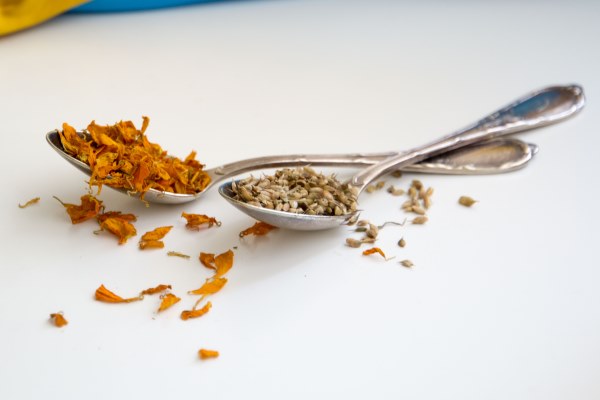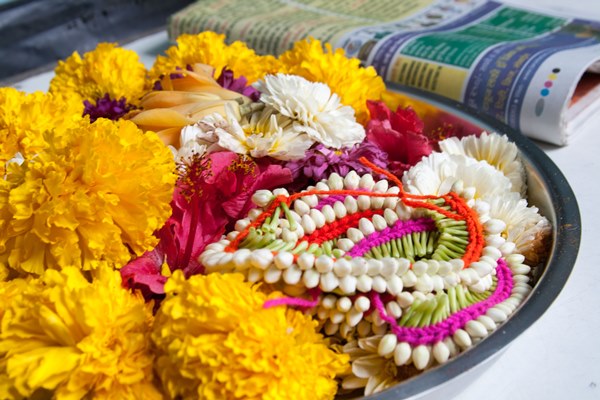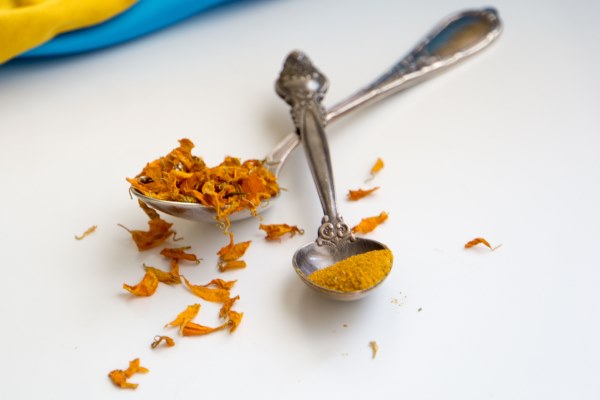OCTOBER 16, 2017 by Victoria in Food & Fragrance, Spices
Yellow Marigolds and Blue Fenugreek : Georgian Spices
I didn’t know that tagetes were edible until I went to Georgia. My grandmother cultivated several varieties for her flower beds, and I loved the spicy, green scent of the flowers we affectionately called chornobryvtsi, the black-eyebrowed ones, since dark eyebrows are one of the hallmarks of classical Ukrainian beauty. On the other hand, I never knew that they have an equally alluring flavor and that it forms the main accord of Georgian cuisine.

Several varieties of tagetes are edible, but the most common one is tagetes patula. That’s the same flower woven into Indian garlands to decorate gods and honored guests, but only in Georgia is it used as food. The flavor of tagetes is earthy, spicy, with a hint of green apple and orange. It plays a base note in the finished dish, lending a lingering brightness to chakhokhbili, chicken stew with tomato and herbs, spice blends, chili pastes, or walnut sauces.

In Georgian, tagetes are called kviteli kvavili, which means yellow flower, or Imeretian saffron. When sold abroad, the spice is called yellow marigold, or incorrectly, safflower. Since yellow flower or yellow marigold is the most common name, that’s how I will refer to it. Below you’ll find links to online stores on both sides of the Atlantic where Georgian spices can be found, but to help you discover this novel flavor, I’m including several photos showing yellow marigold whole and powdered. In contrast to calendula, which looks similar when dried, yellow marigold has a sweet flavor, without any medicinal, bitter notes. And unlike true safflower, it’s less vividly tinted and has more perfume and taste.

You can find recipes that use marigold either in the Georgian cookbooks I reviewed recently or online (Georgian Cooking With Nino on Youtube has few recipes so far, but they’re authentic and easy to follow). You can also try adding 1/2 teaspoon of ground yellow marigold to a bean soup or chicken stew. It marries well with coriander, cumin, chili pepper and onions. You can also fry ground marigold in butter and use it to garnish vegetable soups. It doesn’t have any substitutes, so if you can’t find it, just omit it.
Blue Fenugreek, Utskho Suneli
Another important spice in Georgian cuisine is blue fenugreek. You’ll generally find it under the name of utskho suneli, while its Latin appellation is Trigonella caerulea. It belongs to the same family as the fenugreek used in Indian cooking, but blue fenugreek has a milder, sweeter flavor reminiscent of walnuts and autumnal leaves. It’s picked towards the end of its bloom, and the seed pods are dried. When whole, they have a mild scent, but as soon as they’re ground, they develop a rich, warm perfume. Perhaps, that’s why in Georgian blue fenugreek is called utskho suneli, “suddenly appeared spice.”

Blue fenugreek is used in vegetable dishes, in any preparation that includes walnuts, with meat, poultry and a special salt blend called Svaneti salt. Its savory flavor is almost addictive, and besides Georgian dishes, you can try using it to season ground chicken for spicy meatballs, in lentil soups or in spinach dishes. The best substitute is dried fenugreek leaves which are sold at the Indian grocery store as kasuri methi. Regular fenugreek can also be used as a substitute in the proportion of 6 crushed regular fenugreek seeds for every teaspoon of ground blue fenugreek.
Ombalo
Another unusual spice used in Georgian cooking, particularly in spice mixtures and in tkemali, sour plum sauce, is ombalo. Ombalo has a minty, delicately bitter flavor, and it can be used fresh as well as dried. Mentha pulegium, commonly known as pennyroyal, has a similar flavor. It’s used in small quantities. You can substitute it with dried mint.

Kondari, Summer Savory
The rest of the Georgian spices are the familiar variety such as coriander, cumin, black pepper, chili pepper, dried basil, lovage (celery leaves), dill, mint, and parsley. Often in Georgian recipes you encounter kondari, which is summer savory, Satureja hortensis. It has a green, minty flavor with the lemony sweetness of thyme. In my photograph, the Georgian summer savory, which I bought in Tbilisi, is on the left, while the French summer savory I found at a spice store in Brussels is on the right. The Georgian variety has a more intense color and smaller leaves than the French one, but their flavors are similar.
(Eating dry herbs is a dubious pleasure, but because I’m a geek a good researcher, I also compared the two summer savories to the herb called chubritsa in Bulgarian. It’s also summer savory, and its taste is similar.)
If you don’t already use summer savory in your cooking, I can’t champion it enough. It has a vivid flavor, but without the medicinal assertiveness of herbs like oregano and marjoram. You can use it instead of thyme, or you can pair them together. One of the simplest dishes I learned in Georgia is sauteed mushrooms. Heat vegetable oil in a pan large enough to accommodate oyster or brown mushrooms sliced thickly. Add mushrooms and toss them in oil to brown the edges. Add garlic, summer savory, black pepper, and salt to taste.

Khmeli Suneli
The crowning glory of Georgian spices is a blend called khmeli suneli. It includes up to 15 different herbs and spices and has a heady perfume dominated by the burnt orange notes of coriander seeds. It can be used in marinades for vegetables, chicken, fish, and lamb chops. You can add it to soups and sauces. You can use it in bean ragouts and seafood stews. It adds a sunny yellow color to finished dishes and a complex aroma with well-defined top, heart, and base notes.
Where to Find Georgian Spices
In the US, you can find Georgian spices at Bazaar Spices and on Amazon. In Europe, I order them from Suneli.uk, a website I highly recommend for excellent quality and fast shipping. Suneli.ukalso carries pickled jonjoli blossoms, a must-try for anyone who likes pickled and fermented foods. It’s made only with salt, water and the flowers of a Colchis bladdernut tree native to Georgia, and is crunchy, tart and refreshing.
Store all spices in a cool, dry place. Khmeli suneli can be kept in a freezer to preserve its fragrance.
Photography by Bois de Jasmin


Recent Comments